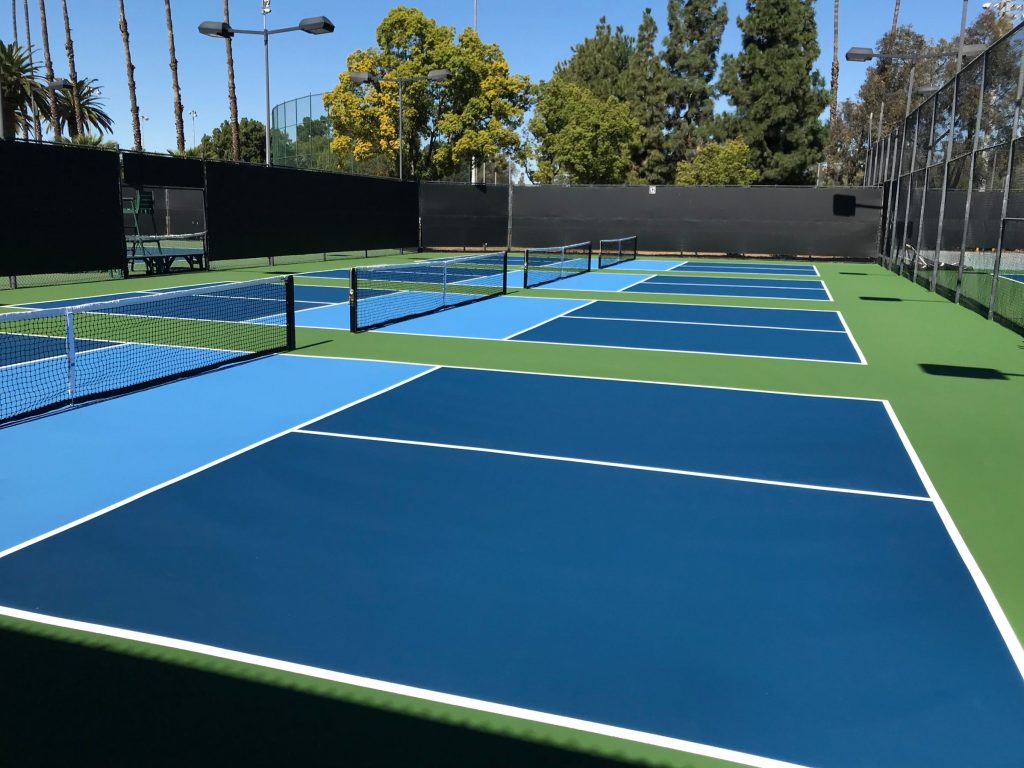What to Expect from Pickleball Courts Style & Building And Construction in Illinois and Midwest
What to Expect from Pickleball Courts Style & Building And Construction in Illinois and Midwest
Blog Article
Key Consider the Building And Construction of Pickleball Judiciaries: From Site Choice to Final Coatings
The building of pickleball courts encompasses a variety of vital factors, starting with the selection of a proper site that stabilizes accessibility with ecological considerations. Crucial aspects such as court measurements, surface products, and drainage systems substantially affect not just the high quality of play yet likewise the long life of the facility. Interest to lights and finishing touches can raise the total experience for gamers and spectators alike. Comprehending just how each of these components interrelates may expose understandings that are frequently ignored, motivating a closer assessment of ideal practices in court construction.
Site Choice Requirements
When getting started on the construction of pickleball courts, it is important to pin down the website choice standards that will certainly make certain optimal playability and accessibility. The location must be easily reachable for players, preferably located near suburbs or area centers, to encourage involvement.
Furthermore, the terrain ought to be level and stable, as irregular ground can bring about safety and security dangers and impact gameplay. Sufficient drainage is additionally essential; picking a website with good water runoff will certainly assist maintain court problems throughout unfavorable weather.
An additional crucial consideration is the availability of energies. Access to electrical power and water is necessary for lights and maintenance objectives. Furthermore, proximity to vehicle parking facilities is crucial, assisting in easy access for gamers and spectators alike.
Ecological aspects can not be overlooked; all-natural shade from trees can boost player convenience, while exposure to dominating winds may interfere with play. Zoning policies and area support must be considered to make sure that the project lines up with neighborhood guidelines and gets the support it requires for successful application. By meticulously assessing these standards, stakeholders can create an inviting and practical setting for pickleball enthusiasts.
Court Dimensions and Design
To ensure optimal gameplay and adherence to policies, the measurements and format of pickleball courts should be thoroughly defined. A conventional pickleball court determines 20 feet in size and 44 feet in size for both songs and doubles play.
The web height is evaluated 36 inches at the sidelines and 34 inches at the facility, producing a small dip that affects round trajectory. Court markings are just as important; lines need to be 2 inches wide and unique in shade to guarantee visibility.
In addition, a barrier area bordering the court is a good idea, typically prolonging 5 to 10 feet beyond the sidelines and baselines to accommodate players' movements and improve safety. Appropriate layout and dimensions not just make sure conformity with official regulations but likewise improve the general having fun experience, accommodating both leisure and competitive play. Cautious planning in these areas is extremely important to the successful building of pickleball courts.
Surface Product Options
Choosing the right surface area material for pickleball courts is important for making sure ideal player performance and safety. The option of surface area can dramatically affect gameplay, including ball bounce, a knockout post grip, and gamer convenience.
There are several choices available, each with its unique qualities. Asphalt is a prominent choice because of its durability and reduced upkeep demands. It provides a solid having fun surface that can stand up to numerous climate condition but might need regular resurfacing.
Concrete is an additional commonly used material, supplying exceptional longevity and a smooth finish. It permits regular sphere bounce but can be hard on gamers' joints, making it much less preferable for long-lasting play without proper cushioning.
For those seeking enhanced comfort and shock absorption, supported acrylic surface areas present a practical choice. These surface areas combine a base layer with an acrylic overcoat, giving boosted grip and a softer feel, which is useful for decreasing the risk of injuries.
Finally, synthetic grass is getting traction, specifically for multi-purpose centers. Its versatility and lower maintenance needs make it an appealing option, though it may not provide the exact same sphere response as typical tough courts. Mindful consideration of these choices will guarantee an optimal having fun atmosphere.
Water Drainage and Illumination Considerations
Correct water drainage and efficient illumination are necessary elements in the construction of pickleball courts, dramatically influencing both playability and safety and security. Ample drainage systems avoid water buildup, which can lead to unsafe surfaces and damage to the court structure.
Illumination is equally essential, you could check here particularly for courts meant for evening use. The placement of lighting components need to be strategically prepared to get rid of darkness and give even distribution of light throughout the court.

Last Surfaces and Maintenance
After resolving drain and illumination factors to consider, focus turns to the final finishes and ongoing maintenance of pickleball courts. Typical choices consist of acrylic finishes and specialized sports surface areas that give ideal grip and cushioning.

Seasonal upkeep may consist of resurfacing every few years, depending upon use and environmental elements. Correctly preserving webs, court lines, and bordering areas is equally vital to give a secure and delightful playing experience. By buying high quality finishes and sticking to a structured upkeep timetable, facility owners can guarantee their pickleball courts continue to be in exceptional condition for many years to come.
Conclusion
In verdict, the successful building of pickleball courts depends upon thorough attention to a number of key variables. Site selection should prioritize availability and surface security, while court dimensions and format must stick to ideal criteria for gameplay. The option of surface material dramatically influences player safety and security and performance. Moreover, effective water drainage and ample lighting add to court long life and presence. Lastly, high quality finishes and a durable maintenance schedule are important for protecting the court's problem, boosting the overall experience for players and spectators alike.
Report this page